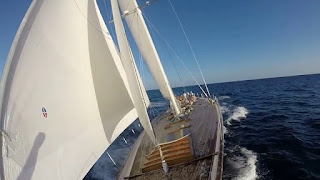Making a Caravel Sail
A few years back we began to hear of a ship being built down Warrnambool way inspired by the famous mysterious "Mahogany Ship". It turned out to be an authentic Caravel crafted by Graeme and Felicite Wylie. Having a strong and passionate interest in maritime history fuelled by family
association I was very excited to be approached to make the sails for the "Notorious" as the vessel was to be known.
| The sail took up our entire small loft |
The original set we made from standard 8oz cruise Dacron and they did years and miles of service. Interesting the UV breakdown seemed to be retarded by Graeme painting the pristine white sails in a deep tan colour.
We followed the voyages of the "Notorious" with interest and admired the vessel when she was moored in the RGYC marina.
We were very excited to hear from the Wylie's to made a new larger sail to replace the old mainsail which had an add-on bonnet sail underneath.
The main criteria for us was to do this fine vessel justice with the new sail being as traditional as possible in this modern day and age.
| Layers of reinforcing in corners |
The first priority was to find a suitable cloth. Not that easy in modern times with Tupperware boats and performance based sails. After shopping around our friends at Dimension Polyant located a roll of 11oz Tall Ship fabric in their plant in Germany. We procured this as quickly as possible and it was shipped out to Australia. The cloth was woven in their FT finish with minimal resin and a tight weave, this provides a soft hand and excellent longevity. Desirable features in this project.
At this stage we did make one concession to the modern era of CAD/CAM industry and had the sail panels cut on a computer plotter to our
| Corner detail. |
design for the sake of expediency. Once these arrived we were underway after clearing away the floor.
Three rows of V138 solarstop thread on each seam was used to ensure a strong join. After seaming up the sail, we were ready to fit all the reinforcing and edging. As the sail was computer cut the luff, leech and foot were already marked and trimmed ( remember I mentioned expediency).
The corner patches were all hand cut and multiple tapering layers fitted in each corner. Then the sail edges were covered in tape and adjustable leech and foot lines fitted.
Sail corners and attachments were a combination of SS O rings with bars webbed into the main three corners, reefing points on foot and leech were SS pressed rings with webbing and the attachment points to the yard were grommets fitted in over extra reinforcing patches.
Then finally the primary corners of peak, tack and clew were finished with leather and the sail was ready to ship.
Thanks to Graeme and Felicite for the opportunity to work on such a great project. We hope the sail gives you years of service and is part of many adventures.
Keep an eye out for the Notorious, she may well be making her way to a port near you.




Comments
Post a Comment